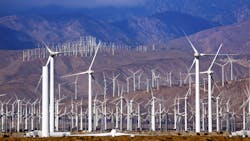Study Outlines Nearly 20% California Electricity Cost Savings
By accelerating the pace at which it deploys renewable energy, California can cut its overall cost of electricity generation by nearly one-fifth, according to modelling in a new study from global technology firm Wärtsilä.
In fact, Wärtsilä’s “Front-loading Net Zero” study finds the Golden State could achieve 100% renewables by 2040 – five years ahead of schedule – and cut its overall electricity costs by 17% as a result. The company reasons that lower electricity production costs between now and 2045 – driven by lower operating costs for renewables – offsets the capital expenditure needed to create a 100% renewable power system. It points out that California’s 100% renewable system will comprise renewable energy, along with technologies needed to balance its intermittency – such as batteries and thermal balancing power plants.
Wärtsilä argues the economics support “front-loading” the introduction of renewable energy to create a 100% carbon neutral grid in California and other states as early as possible. The firm’s analysis finds that hitting a 100% Renewable Portfolio Standard (RPS) in 2045 – California’s current goal – would cost an extra $14 billion. It attributes the extra cost of not accelerating, or front-loading, renewables deployment to rising carbon taxes.
“The path to 100% renewables is a profitable one for California,” remarked Karl Meeusen, Wärtsilä director of markets, legislative, and regulatory policy and a report co-author. “The faster the system hits net zero emissions, the greater the reduction will be both on energy costs and carbon emissions. California – and the U.S. as a whole – has a mountain to climb in reconfiguring its energy systems for net zero, but it’s certainly viable with technologies that are already available at scale.”
The study concludes that California faces major planning challenges in its quest for a carbon-neutral power system, with an output increase from 280 terawatt-hours (TWh) to 420 TWh.
“Demand for new technologies such as electric vehicles, plus the production of renewable sustainable fuels such as green hydrogen from wind and solar PV generation, will dramatically increase the overall demand for power, requiring enormous growth in the overall capacity of renewable energy and flexibility in that state,” Wärtsilä noted.
Renewables output findings from the study include:
- Wind power needs to increase by 300%, from 10 gigawatts (GW) in 2020 to 40 GW in 2045.
- Solar PV needs to increase by 276%, from 29 GW in 2020 to 109 GW in 2045.
- Energy storage capacity needs to increase by 800% from 4 GW in 2020 to 36 GW in 2045.
“To realize California’s 100% renewable transformation, leaders must create a system where renewable energy and flexibility work symbiotically,” continued Meeusen. “By acting faster, today, California and the U.S. can create net zero power systems with enormous economic benefits and draw a blueprint for the world to follow.”
Wärtsilä stated that it ran the power system modelling in the report using the power market simulation software Plexos. It noted the modelling defined a cost-optimal energy system structure and operation mode based on the following constraints in each region: power demand, available generation and storage and balancing technologies, financial and technical assumptions, and limits on installed capacity for all applied technologies.
About the Author
EnergyTech Staff
Rod Walton is senior editor for EnergyTech.com. He has spent 17 years covering the energy industry as a newspaper and trade journalist.
Walton formerly was energy writer and business editor at the Tulsa World. Later, he spent six years covering the electricity power sector for Pennwell and Clarion Events. He joined Endeavor and EnergyTech in November 2021.
He can be reached at [email protected].
EnergyTech is focused on the mission critical and large-scale energy users and their sustainability and resiliency goals. These include the commercial and industrial sectors, as well as the military, universities, data centers and microgrids.
Many large-scale energy users such as Fortune 500 companies, and mission-critical users such as military bases, universities, healthcare facilities, public safety and data centers, shifting their energy priorities to reach net-zero carbon goals within the coming decades. These include plans for renewable energy power purchase agreements, but also on-site resiliency projects such as microgrids, combined heat and power, rooftop solar, energy storage, digitalization and building efficiency upgrades.
